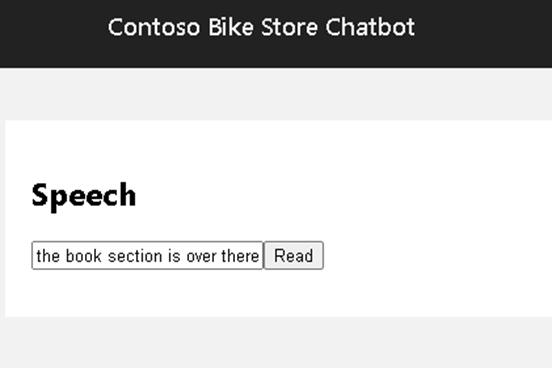Speech Processing
In this tutorial, you'll learn how to implement text-to-speech capabilities using Azure Speech Services to enhance accessibility and user experience.
What you'll build: A speech synthesis system that converts text to natural-sounding speech.
What you'll learn:
- Azure Speech Services integration
- Browser audio playback
- Accessibility considerations
- Speech synthesis customization
Learning Objectives
By the end of this tutorial, you will be able to:
- Integrate Azure Speech Services for text-to-speech
- Configure voice settings and output formats
- Handle audio playback in web browsers
- Implement accessibility features for diverse users
Scenario
Your retail store wants to enhance accessibility and provide a more natural, engaging experience for customers. The goal is to implement text-to-speech (TTS) to improve efficiency and self-service capabilities, allowing shoppers to receive audio information about products, navigation, and promotions.
Goal
Implement text-to-speech functionality that reduces reliance on staff while maintaining a personalized touch through natural-sounding voice interactions.

Step-by-Step Implementation
Step 1: Understanding Azure Speech Services
Azure Speech Services provides:
- High-quality neural voices
- Multiple languages and accents
- SSML (Speech Synthesis Markup Language) support
- Real-time and batch processing
- Customizable voice models
Step 2: Examine the Speech Component
Navigate to apps-chat\chatbot-frontend\pages\speech\Speech.tsx. You'll find:
- A text input for content to be spoken
- A read button to trigger speech synthesis
- Placeholder for audio playback controls
Step 3: Set Up Speech Configuration
Before implementing the speech API, you need to:
- Configure the Speech SDK
- Set up authentication with your Speech service
- Choose appropriate voice and language settings
useEffect(() => {
const speechConfig = SpeechConfig.fromSubscription(
'YOUR_SPEECH_KEY',
'YOUR_REGION'
);
// Configure voice settings
speechConfig.speechSynthesisVoiceName = 'en-US-AriaNeural';
speechConfig.speechSynthesisOutputFormat = SpeechSynthesisOutputFormat.Audio16Khz32KBitRateMonoMp3;
// Initialize synthesizer
const synthesizer = new SpeechSynthesizer(speechConfig);
}, []);
Step 4: Implement Speech Synthesis
Your task is to complete the speechApi function to:
- Convert text to speech using Azure Speech Services
- Handle the audio output appropriately
- Manage playback in the browser
- Provide user feedback during processing
Key Implementation Steps:
async function speechApi(text: string): Promise<void> {
return new Promise((resolve, reject) => {
synthesizer.speakTextAsync(
text,
result => {
// Handle successful synthesis
// Play audio in browser
resolve();
},
error => {
// Handle errors
reject(error);
}
);
});
}
Step 6: Solution Reference
View Complete Solution
Try implementing it yourself first!
Click to reveal the solution code
import React, { useState, useEffect, useRef } from "react";
import { trackPromise } from "react-promise-tracker";
import { usePromiseTracker } from "react-promise-tracker";
import * as sdk from 'microsoft-cognitiveservices-speech-sdk';
const Page = () => {
const { promiseInProgress } = usePromiseTracker();
const [speechText, setSpeechText] = useState<string>("");
const synthesizerRef = useRef<sdk.SpeechSynthesizer | null>(null);
const speechConfigRef = useRef<sdk.SpeechConfig | null>(null);
useEffect(() => {
const speech_key = '<Speech_Service_API_Key>';
const speech_region = 'eastus';
speechConfigRef.current = sdk.SpeechConfig.fromSubscription(
speech_key,
speech_region
);
speechConfigRef.current.speechSynthesisVoiceName = 'en-US-AriaNeural';
speechConfigRef.current.speechSynthesisOutputFormat =
sdk.SpeechSynthesisOutputFormat.Audio16Khz32KBitRateMonoMp3;
synthesizerRef.current = new sdk.SpeechSynthesizer(
speechConfigRef.current
);
return () => {
if (synthesizerRef.current) {
synthesizerRef.current.close();
}
};
}, []);
async function process() {
if (speechText && synthesizerRef.current) {
trackPromise(speechApi(speechText));
}
}
async function speechApi(text: string): Promise<void> {
return new Promise((resolve, reject) => {
if (!synthesizerRef.current) {
reject(new Error('Speech synthesizer not initialized'));
return;
}
synthesizerRef.current.speakTextAsync(
text,
result => {
if (result.reason === sdk.ResultReason.SynthesizingAudioCompleted) {
console.log('Speech synthesis completed');
// Audio is automatically played by the SDK
resolve();
} else {
reject(new Error('Speech synthesis failed'));
}
},
error => {
console.error('Speech synthesis error:', error);
reject(error);
}
);
});
}
const updateText = (e: React.ChangeEvent<HTMLInputElement>) => {
setSpeechText(e.target.value);
};
return (
<div className="pageContainer">
<h2>Speech</h2>
<p>Enter text below to hear it spoken aloud using Azure Speech Services.</p>
<div>
<input
type="text"
placeholder="(enter some text to be read aloud)"
value={speechText}
onChange={updateText}
style={{ width: '300px', marginRight: '10px' }}
/>
<button onClick={process} disabled={!speechText || promiseInProgress}>
Read
</button>
<br />
{promiseInProgress && <span>Processing speech...</span>}
</div>
</div>
);
};
export default Page;
Step 7: Testing it out
- Replace
<Speech_Service_API_Key>placeholder value by looking up https://aiaaa-s2-setting.azurewebsites.net - Go to
apps-chat\chatbot-frontendfolder in terminal windows and runnpm run dev - Navigate to
Speechpage in the top navigation bar - Type some texts into the input box
- Click
Readto play the speech (use Chrome for best compatibility)
Real-World Applications
Retail Environments
- Product information announcements
- Store navigation assistance
- Promotional content delivery
- Accessibility for visually impaired customers
Customer Service
- Automated phone responses
- Kiosk voice guidance
- Multi-language support
- Queue management announcements
E-learning and Training
- Course content narration
- Interactive tutorials
- Assessment feedback
- Language learning pronunciation
Integration Opportunities
- Chatbot Integration: Add voice responses to chat interactions
- Notification Systems: Speak important alerts and updates
- Workflow Automation: Voice-guided step-by-step processes
- Multilingual Support: Combine with translation for global accessibility